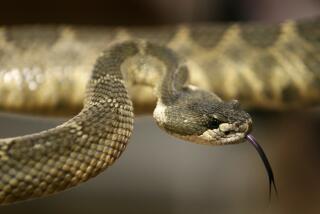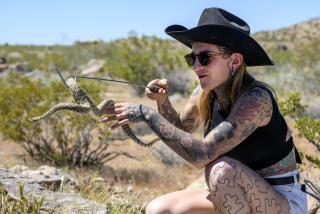Rattle Trap : Recreation: In the South, hunters catch and cage snakes for fun and profit. Conservationists brand the annual roundups as cruel.
CLAXTON, Ga. — There’s nothing like a few hundred rattlesnakes to get your senses racing.
The smell hangs in the air, heavy, musky. More than 500 frightened and angry snakes huddled in a warehouse create a powerful aroma that seems to follow you days later.
Then there’s the sound of the rattles, a bzzzzzzzzzzzzz, multiplied hundreds of times. In 8-foot-long wire cages the snakes crawl over one another, up but not out, flicking their black tongues, occasionally coiling and from time to time striking at imaginary victims.
Beige and brown on top with black markings, these Eastern diamondbacks look like shapely sections of garden hose sliced lengthwise. They range from 3 to 6 feet long and feel as beautiful as they look, cool, firm, dry. They also, of course, are deadly if they sink their venom-filled fangs into your skin.
Fortunately, none escaped during this year’s Rattlesnake Roundup in this town of 2,400, about 55 miles west of Savannah. The rest of the year, Claxton is known as “the fruitcake capital of the world,” but for one weekend every March the town shucks off that homey image and embraces an orgy of rattler-related events.
It is but one of many small towns throughout the Sunbelt that celebrate the capture and display of the vipers in what supporters call “winter sporting events.” Although hunters say they are ridding the countryside of danger and having a little fun to boot, herpetologists and conservationists brand the hunts as cruel and say the snakes should be left in the wild, where they destroy rats and other pests. It is a controversy that grows with each roundup.
The hunts began here in 1968, the year after a local youngster named David Wiggins was bitten three times by a rattler while picking vegetables. He survived, and folks around here say that catching snakes--they are sold live for their venom--will ensure that others escape the pain Wiggins suffered.
“I’d rather hunt snakes in the wintertime than walk through the (snake-infested) woods in the summertime,” declared Lex Strickland, president of the local chamber of commerce.
But Howard Hunt, curator of herpetology at Zoo Atlanta, sees the roundups as nothing less than a “barbaric, primal activity.”
He charges that they “exploit the idea that people are afraid of snakes,” adding sarcastically: “Isn’t this a great idea to round up rattlesnakes? What heroes these must be! What dangers they must endure to save us from a dread menace out there! That’s the hype. . . .”
Another herpetologist, David Auth of the University of Florida, conceded that snakes “have two strikes against them”: Most people, he asserted, want to “whack off their heads,” plus “they don’t have legs” to run away. But the fact is, he said, “they provide excellent rodent control--much better than cats.”
Rattlers often hibernate in tortoise holes, and opponents of hunting complain that these holes and their inhabitants are sometimes destroyed during hunts.
But Danny Strickland, Lex’s brother and president of the Evans County Wildlife Club, sponsor of the Claxton roundup, rejects the criticism as unfair.
“We’re environmentalists. We love nature, too,” he said. “We like to capture a few because nature can only support so many snakes.”
Nevertheless, arguments against the roundups have put hunters on the defensive. For example, you can’t get fried rattlesnake meat at the Claxton roundups anymore. Seems opponents pointed out that the meat wasn’t government-inspected and certified, and somebody suggested that the club might be sued if anyone got sick from eating the stuff. (Like a lot of exotic meat, rattler is said to taste like chicken. Opponents ask, Well, why not just eat chicken?)
“Our better judgment told us to leave that (serving rattler) to the restaurants in New York and Los Angeles,” Danny Strickland said.
Controversy aside, the roundups go on, from Georgia to Arizona.
Last Saturday in Claxton, members of the wildlife club held a “celebrity snake hunt,” a kind of demonstration for the uninitiated that included a couple dozen winners of beauty pageants around Georgia--including last year’s Miss Rattlesnake Roundup and this year’s aspirants.
About three dozen people were taken to the woods outside town, where hunter Billy Odom jammed a plastic tube containing about a teaspoonful of gasoline into a hole in the ground and Danny Strickland conducted a seminar.
“We’re not here to scare anybody,” Strickland said. “We’re just here to show you girls how we catch snakes.”
After about 10 minutes, when the gasoline fumes took effect, the groggy snake stuck its head out. Then, sensing danger from the huge semicircle of observers--several rather large men included--the rattler retreated underground.
Two men began digging with shovels, while Odom probed with a stick. Eventually, the hunter, using a 4-foot pole with a hook on the end, snared the dirt-covered reptile and laid it on the ground. There, the snake slowly warmed under the midday sun and began rattling its tail and a few nerves.
“If we leave him out here about 30 minutes, he’d liven up,” said Strickland.
“I like him the way he is,” said Miss Altamaha, Rhonda Wilcox. “You don’t have to liven him up.”
As the visitors piled back into the caravan of vehicles, the snake was presumably gathering strength to join the others in the warehouse.
This year’s Claxton hunt began in January and resulted in the capture of 558 rattlers, eclipsing the previous record of 373 in 1986. Hunters, who liken their sport to hunting deer or rabbits, stored the snakes in plywood boxes and other containers until the March roundup, then took them to the cavernous Claxton tobacco warehouse, where they were measured, weighed and put into cages.
Like an indoor county fair, the roundup featured woodcraft objects for sale, food stalls, clogging groups and just about everything imaginable made from snake hides: belts, boots, wallets, knife scabbards, earrings, key rings.
At the back of the building, where the live snakes were piled up in the cages, an audience looked on, watching them writhe.
Why? What makes more than 25,000 people pay to watch snakes wiggle around in cages?
When a visitor asked one woman that question, another snickered and whispered to her: “They’re a lot like men.”
Physically or emotionally? “Yes,” she answered.
More seriously, part of the fascination seems to be the controlled danger. “My heart was beating fast,” said Jan Wolfe of Vidalia, Ga. “It’s a danger that cannot get to me.”
But the thought of it gets to you. After hearing, seeing and smelling half a thousand snakes for two days, one becomes keenly aware of small sounds, such as branches cracking. And sudden movements by any crawling creature become ominous.
This is the stuff that appeals to hunters. Similar to the killing of game, with the camaraderie of men chasing animals in the woods, the catching of snakes that could kill the killer escalates the experience to a headier plane. Apparently, hunters love getting scared.
And because prizes are given to hunters with the biggest and the most snakes, the roundup offers the thrill of victory, much like a baseball game. Throughout last Saturday afternoon, teams of hunters brought in their snakes, getting them weighed and measured by handlers from the club.
John McDilda and Norwood Rogers led the winning team, catching 130 snakes and bringing in the biggest reptile, 6 feet long and weighing almost 11 pounds.
McDilda, a perennial winner, had been low-key all afternoon as other teams dragged in their catches. Dressed in blue jeans, brown Western boots, blue Windbreaker and a brown felt hat with a snakeskin band and a rattler ornament, he finally showed emotion when it became clear that his team wouldn’t be beat.
“It was hard work,” he said, grinning broadly.
Tonya Strickland, a high school senior and Danny Strickland’s daughter, was crowned Miss Rattlesnake Roundup of 1991, chosen for poise and beauty. And she’s not a bad diplomat, either. Asked whether the honor has made her love snakes, the new queen responded: “I respect snakes; I don’t love them.”
Although critics speculate that snake roundups are money cows, local residents play down financial considerations.
The club buys the snakes from the hunters, this year paying $10 a foot, then sells them to Bioactive Inc., an Arlington, Va., firm that extracts the venom for snakebite antidote and medical research. Club officials say they spend at least $35,000 a year on the roundup and contribute some of their proceeds to scholarships and other causes.
McDilda said the more than $5,500 his team was paid for snakes would hardly pay expenses incurred in months of hunting. “It takes a lot of miles and a lot of traveling to catch 130 snakes,” he said.
Last weekend, Ken Darnell, owner of Bioactive Inc., was on the scene at the back of the warehouse, checking on the health of his newly purchased snakes--milking them before hundreds of fascinated onlookers crowded around a fenced-in ring. As he worked, he explained the procedure.
Grasping a rattler with one hand, Darnell squeezed its jaws with the other, milking venom into a glass container, then squirting a little Betadine into the reptile’s mouth to prevent infection. He estimates that he milks 10,000 snakes a year.
How dangerous is this? Has he ever been bitten?
Darnell, bearded and beefy enough to hold onto a 6-foot rattler with no sweat, apparently loves such questions.
His answer: “My wife bit me once. I almost died.”





